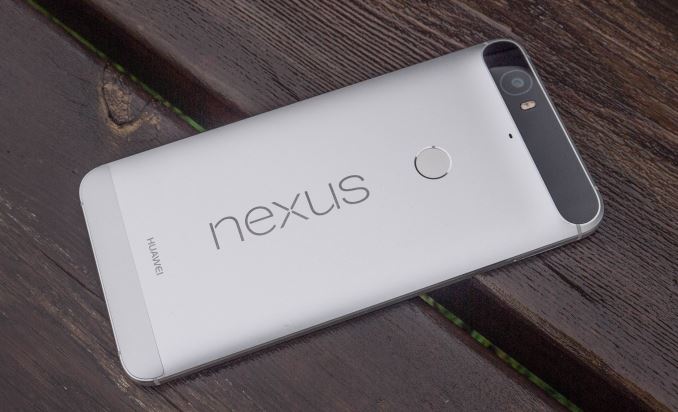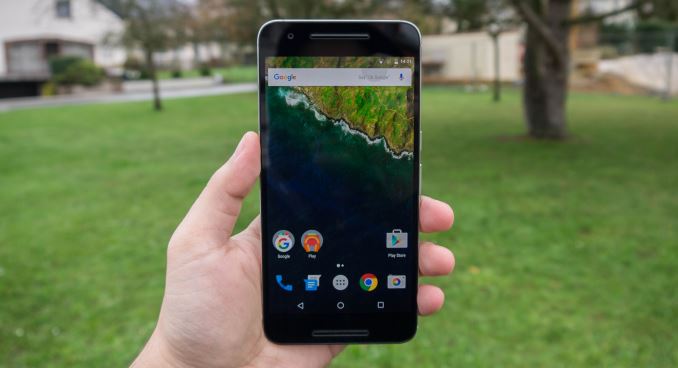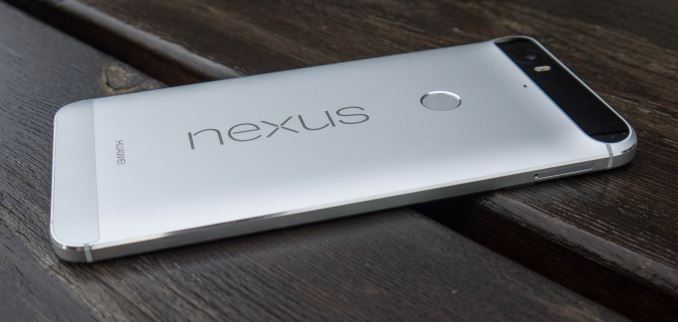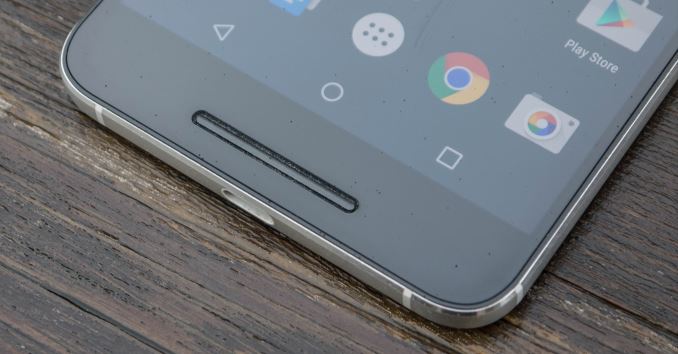The Google Nexus 6P Review
by Andrei Frumusanu on December 16, 2015 8:00 AM EST
As we have come to know, Google has opted to simultaneously release two Nexus smartphone devices this year. Alongside the smaller form-factor LG Nexus 5X which we’ve reviewed a couple of weeks ago, we also find the larger Huawei-built Nexus 6P. The Nexus 6P is the successor to last year’s Motorola Nexus 6. The new device also marks a first for Google’s Nexus line-up: the introduction of Huawei as a hardware partner.
The symbiosis created by the collaboration between OEMs and Google for Nexus devices is quite unique in the market and is more similar to how ODMs operate. In the case of the Nexus devices the hardware vendors make their design resources and production lines available to Google. This usually means that a Nexus device from a given vendor will most of the time be remarkably similar in build to what the OEM offers for their own product lines at that moment in time. As we’ve seen in the past this has been valid for the last few generations of Nexus’, where for example the Nexus 6 took design cues from Motorola’s own Moto X devices or LG’s Nexus 5X sporting very typical LG build characteristics.
The Nexus 6P is no different in this regard. Huawei has had a long history of producing metal frame devices and in the past few years has even made this a trademark design characteristic of their latest models. In terms of build the Nexus 6P clearly reminds of the Mate series and even has some design cues that are similar to the recently announced Mate 8.
While in terms of design we can see a fair bit of input and design language from the vendors, the actual specifications of the device’s internal hardware are heavily influenced by Google’s own choices. As such, we go over the specifications of the Nexus 6P:
| Huawei Nexus 6P | ||
| SoC | Qualcomm Snapdragon 810 4x Cortex A53@1.56GHz, 4x Cortex A57@1.95GHz Adreno 430 @ 600MHz |
|
| RAM | 3GB LPDDR4 | |
| Storage | 32GB / 64GB / 128GB NAND | |
| Display | 5.7” 1440p Samsung AMOLED Gorilla Glass 4 |
|
| Modem | 2G / 3G / 4G LTE UE Category 10 (SoC Integrated Qualcomm Gobi Modem) |
|
| Networks North America (H1511 / A1) Rest of world (H1512 / A2) |
TDD LTE | B38 / B39 / B40 / B41 |
| FDD LTE | B1 / B2 / B3 / B4 / B5 / B7 / B8 / B9 / B12 / B13 / B17 / B19 / B20 / B25 / B26 / B28 / B29 / B30 | |
| UMTS | 800 / 850 / 900 / 1700 / AWS /1900 / 2100 ( B19 / B6 / B5 / B8 / B9 / B4 / B2 / B1) |
|
| CDMA | BC 0 / 1 / 10 | |
| GSM | 850 / 900 / 1800 / 1900 | |
| Dimensions | 159.3 (h) x 77.8 (w) x 7.3 (d) mm, 178 grams |
|
| Cameras | Rear | 12.3MP ( 4032 x 3024 ) Sony IMX377 Sensor w/ 1.55µm pixels F/2.0 aperture, 26mm eq. |
| Front | 8MP ( 3264 x 2448 ) Sony IMX179 w/ 1.4µm pixels F/2.4 aperture, 26mm eq. |
|
| Battery | 3450mAh (13.18 Whr) | |
| OS | Android 6.0 | |
| Connectivity | 802.11a/b/g/n/ac dual-band 2.4GHz & 5GHz BT 4.2, GPS/GNSS, DLNA, NFC, USB-C 2.0 |
|
| SIM Size | NanoSIM | |
| MSRP USA, UK, Eurozone |
32GB | $499 - £449 - 649€ |
| 64GB | $549 - £499 - 699€ | |
| 128GB | $649 - £579 - 799€ | |
The 6P is powered by Qualcomm’s Snapdragon 810 SoC. This is a big.LITTLE with a quad-core ARM Cortex A57 cluster at 1.95GHz serving as the high-performance cluster and a quad-core Cortex A53 cluster running at 1.55GHz serving as the high-efficiency cluster. Graphics are powered by Qualcomm’s own Adreno 430 GPU which should be plenty to serve the 1440p screen of the Nexus 6P. Over this past year there have been some concerns regarding the Snapdragon 810’s efficiency, and we’ll cover how the chipset affects the device’s performance and battery life throughout the review.
The device comes in two different models: a North American model and a rest-of-the-world / international variant. In terms of frequency bands the NA model comes with frequency bands equipped for NA carriers while logically the second model sports bands for all other global carriers. Connectivity is provided by the integrated modem on the Snapdragon 810 offering up to LTE UE Category 10 speeds of up to 300Mbps down and 100Mbps upload.
The 6P shares the same main camera as found on the 5X: A Sony IMX377 sensor module which sports large pixel pitches coming in at 1.55µm. As such the resolution is more limited at 12.3MP but together with the F/2.0 lens system the larger pixels should provide better light sensitivity compared to other sensors on currently available in devices. On the front camera we find the same module found on other Huawei devices this year; an 8MP Sony IMX179 with 1.4µm with an F/2.4 aperture lens system.
The device has a footprint of 159.3 x 77.8mm in height and width, making this a much smaller device than last year’s 6” Nexus 6. The thickness is also much more reduced at a mere 7.3mm. Even in weight and despite that the 6P is a metal design, in comparison to its predecessor it manages to shed off 6g for a total of 178g. This is a clear change in form-factor and the Nexus 6P is in terms of ergonomics more comparable to last year’s Note 4 than it is to the Nexus 6, which subjectively I would deem it to be a very positive change for the average consumer. Even though the 6P is smaller in every metric, it actually manages to ship with a larger battery than the Nexus 6. The 3450mAh 3.82V or 13.18Whr should provide ample power for a good battery life.
As mentioned, the device sports a 5.7” screen with a resolution of 1440 x 2560. This is an AMOLED screen provided by Samsung Display. The Nexus 6 was notorious for having a rather disappointing panel, but this time around Google and Huawei were able to step it up in terms of quality and the 6P’s panel looks very good.
The front of the device is all black and the screen is flanked on both the top and bottom by two front-facing speakers. Actually this is the first phone in my possession with front speakers so I was looking forward to the experience. While it is true that in terms of directionality the Nexus 6P offers a much better experience than mono speakers on other devices, I was a bit disappointed by the quality of the sound output by them. At medium volume the range is very good, even if it somewhat lacks the in terms of bass when compared to Samsung and especially Huawei’s own devices. What I found to be more upset about is that at maximum volume (which is quite loud) we can experience distortions. It’s especially notifications that suffer a lot in terms of quality when at high volume. As opposed to the Nexus 5X’s deceiving speaker design which only offers general audio playback via the bottom speaker, the 6P does offer full stereo experience, but however I found that on my unit the top speaker is ever so slightly louder than the bottom speaker which makes for an odd balance when you view content in landscape. HTC here seems still has a considerable lead when it comes to audio processing and adjusting front-facing speakers for the best experience.
The device’s left side has no features other than the nanoSIM tray, while on the right we find the power button and the volume rocker. I found it weird that the power button was placed above the volume rocker so that’s definitely something out of norm and needs getting used to. The perfectly vertically centred position of the volume rocker also caused me to keep pressing it whenever I picked up the device which I also found to be odd.
At the back of the device we find the large Nexus logo next to the fingerprint sensor. The back is very solid and has no noticeable flex when trying to press on it. At the bottom we find a plastic cover that acts as an RF window for some of the antennas.
The overall device’s ergonomics are good and the flat sides allow it for a good grip with it being rounded off enough by the chamfered edges and slightly curved back to make for a comfortable grip. Again I fall back to the Note 4 comparison as that’s the most similar device in terms of how the Nexus 6P feels, with of course a metal finish instead of the faux-leather plastic.
It’s of course at the top where we find the Nexus 6P’s most recognizable characteristic. The “visor”, as it seems to have become norm to call it, features the main camera as well as a dual-LED flash and IR laser which is used by the laser auto-focus system. The whole feature is around 1mm thicker than the rest of the phone and is covered by a black-accentuated glass cover which curves at the side edges. Personally I don’t mind the design at all and it actually provides a feature which better helps you orientate what is otherwise a very symmetrical device.
The phone comes with a USB Type-C connector but the port itself only implements USB 2.0 connectivity.
All in all the Nexus 6P is a very solid device and I think Google made a good choice in sizing down to 5.7” to try to attract a wider user-base who maybe wasn’t so convinced by the Nexus 6’s very large size. I’m a bit biased on giving opinions about phablets – I did run a 5.7” device as a daily driver for several months only to be happy to scale down back to a 5” form factor after deeming the large device is not a good fit for me. My only gripe is that for the amount of bezel that Google put on the 6P, I expected some more impressive speakers as I would have otherwise preferred a larger screen-to-device footprint ratio, such as found on Samsung’s Note series or Xiaomi’s Note devices. Besides that little critique regarding the bezel, I can objectively see how the 6P could be a perfect device for many users who looking for a larger form-factor.















219 Comments
View All Comments
Djdjndjddjs - Wednesday, December 16, 2015 - link
"even last year’s Snapdragon 801/805 phones" this here just made this review a whole lot less credible.grayson_carr - Thursday, December 17, 2015 - link
How so? He was referring to sustained performance (after throttling) and the Nexus 6P does indeed have a lower framerate than the One M8 (Snapdragon 801) in the GFXBench Sustained Performance test.tuxRoller - Wednesday, December 16, 2015 - link
So, the 6p does a better job than the note 5 at maintaining long-term graphics perf.grayson_carr - Thursday, December 17, 2015 - link
Looks like it. Weird that the Galaxy S6 did a better job than both though. You would think the Note 5 would do better than the S6... same SOC, but seemingly more room to dissipate heat.Sahrin - Wednesday, December 16, 2015 - link
Really important to see the carrier aggregation information for the radio as well, not just the band supported.bmullan - Wednesday, December 16, 2015 - link
The article was TLDR ... but in case the article didn't mention it.... These are the 2 Phones that Google has approved for its Project FI (https://fi.google.com/about/).The Nexus 6P is the one to get if you want to have the transparent auto-switching between 2 different Mobile Providers and also auto-switching with wifi. The Nexus 6 only gets you transparent auto-switching between 1 mobile provider & wifi.
rstuart - Wednesday, December 16, 2015 - link
I bought a 6P a while ago, so I read the article more to get a feel for how well it matches my own thoughts about the phone.Overall, it does. Even it's comments on price are pretty well spot on - I live outside of the US, and if I had to pay for it there is no way I could justify it, even though I happen to prefer stock Android.
I was particularly pleased to see how Qualcomm's clusterfuck, the 810 was presented. There is simply no excuse for producing a SoC that is worse than the previous generation in terms of performance/watt, and yet that is what Quallcomm did. Yet amazingly, Huawei (mostly through the large battery) and Google (using software tricks to keep the thing switched off) managed to mitigate that and produce a device that has a very usable battery life.
Subjectively in everyday use the 6P is very fast, just as the review says. And yes the screen is excellent, although it would be just as good if they dropped the resolution by 1/3 to retina levels and reduced the load off the GPU. The form fact is perfect for a phablet - the screen is large but you can still comfortably operate it with one hand. (Hint Andrei: that is why the buttons are in the middle. You could not reach them if they were on the top. And yes, making them reachable when you pick it up with one hand also means you bump them occasionally.)
It's a pity Andrei didn't comment on USB-C. I make a point of handing the phone plus USB-C cable over to people and you can hear an audible sigh of joy from some as they realise the mental effort of orientating the connect has gone. The connector with its definite click as you push it home is a delight to use. And he neither does he mention the down side - USB-C to traditional USB adaptors is a mess, and as a result you can forget getting those excellent charging results from any of your non USB-C chargers. Instead you get the base rate of 0.5A 5V charging regardless of what your charger is capable of, which means when I'm using the phone for navigation in the car the battery discharges even though plugged in. And there is no wireless charging.
My overall feeling is it is a wonderful phone, the occasional wart doesn't harm the experience. Amazing, given given the clusterfuck of a SoC Huawei and Google had to work with. Still, if I was in a position to wait 12 months I'd be waiting. The 820 is not only back on trend in the performance/watt stakes, it also has a much better LTE modem and it looks like those extra LTE bands international version has is what took the price from "reasonable" to "badly overpriced".
silverblue - Thursday, December 17, 2015 - link
My upgrade is due next Wednesday, and I've been looking at this phone with more than a passing interest, however one or two sites out of the (very happy, I might add) maddening crowd don't appear to be too complimentary about it. We've got a 950 XL here for testing so I'm waiting for more news on that despite the slagging off it's been getting from the press, and I suppose I don't have to upgrade on the deadline day, however there is the small matter of a free £50 Google Play voucher until the 24th which makes it all the more tempting. Additionally, whereas the Note 5 would seem like a good alternative, I'm hearing a lot made about its availability and price, plus Samsung's incessant desire to tell you that their vision of Android is the correct one, and the aforementioned memory management issue, so I'm not considering the Note 5 at this time. Had this review been more positive, I think my mind would've been made up.I could always just wait another month. January sales, and all that.
silverblue - Thursday, December 17, 2015 - link
Of course, the voucher is applicable to the 6P. :) There's also the small matter of the non-availability of the free dock on the 950 series, but then again, it's not as if I'm going to use a phone to do all my work on.grayson_carr - Thursday, December 17, 2015 - link
Your point about only getting the base rate of 0.5A from non USB-C chargers is not correct. Using an Anker charger in my care with the USB A to C cable from the Google Store gets me near 2A, which isn't as fast as the 3A provided by the USB C charger included in the box, but is still fairly fast.